Summary
I collected data on 6 EA-aligned orgs’ recent tweets and used this to determine the “personality” of each account.
I found that:
- Regular tweets with varied content and a consistent tone worked best (in my opinion)
- Twitter personalities can be described along three key axes:
- Objective/Emotive
- Inward/Outward looking
- Shallow/Deep
Introduction
Two weeks ago I posted a quantitative study of EA-related organisations’ social media use across Facebook, Twitter and Instagram. This post adds detail to that study by focusing on the Twitter activity of 6 organisations.
The post starts with an overview of the data collected. Then I describe the “personality” of each Twitter account and identify a lesson we can learn from each one. I end with conclusions on what every org should do on Twitter and how we can think of Twitter personalities along 3 axes.
I expect this post will be interesting for anyone thinking about social media strategy, especially what “personality” they wish their account to embody.
Details on my methodology can be found in the footnotes[1] and the full dataset is linked here. This post uses small sample sizes, so it’s best to see this as a snapshot rather than a robust dataset from which significant conclusions can be drawn.
Data Overview
The organisations selected represent a variety of cause areas within EA, and all are among the 20 most-followed EA-aligned organisations on Twitter[2].
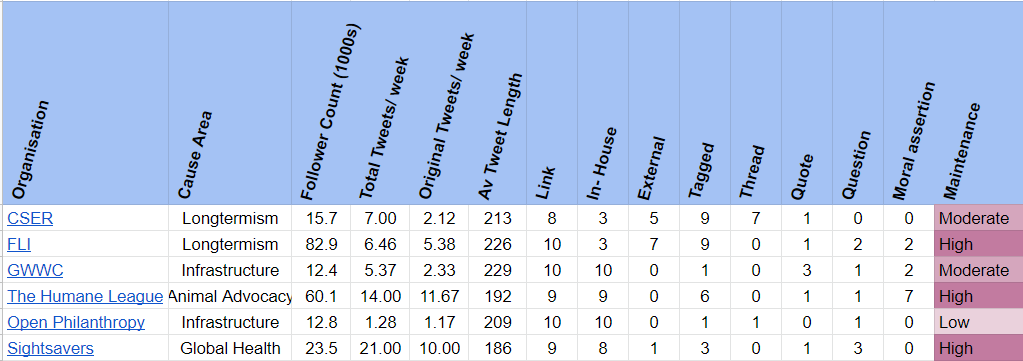
Detail on the variables:
- Original tweets are all tweets that are not retweets or quote tweets. The data in the table is calculated from a dataset of the 10 most recent original tweets from each account [link to footnotes].
- Average tweet length is measured in characters and does not count URLs
- The next few columns indicate how many of the 10 tweets
- Contained a link or embedded video
- contained a link to in-house content (created by the org and/or its members)
- contained a link to external content
- tagged another account
- was the beginning of a thread
- contained a quote
- contained a question
- Included some sort of moral assertion (eg. “AI systems should not decide who lives and who dies.”, FLI, 4 Jan.).
- Maintenance is an estimate of how effort-intensive their Twitter activity is
Commonalities
- All of the orgs included links (and occasionally embedded videos) in most of their tweets, but there was lots of variation in whether orgs linked to their own work or to others’
- All of the orgs used 65% or more of the character limit most of the time: they are typically posting long–ish, multi-sentence tweets. None of the tweets seemed spontaneous
- Tweet threads were rare, and none of the orgs used them to tell a story, the way high-profile individuals often do
- Orgs tended to retweet other orgs and did not retweet high-profile individuals
- Interestingly, none of the 60 tweets in the sample:
- mentioned Effective Altruism
- referenced anything theoretical or philosophical
- used polls or encouraged users to comment with their opinion
Organisation Personalities
Centre for the Study of Existential Risk (CSER)
Key Features
- Mainly uses Twitter to promote stuff their people are doing - even the “external” links primarily drew attention to the work of CSER members
- Continually tagging and retweeting others: Retweets made up 70% of CSER’s output
- The only account in the study to use “mini-threads” of two tweets: view counts for the secondary tweets are much lower
- Extremely objective-sounding - Tweets were mostly descriptive, directing users towards links
Typical Tweet
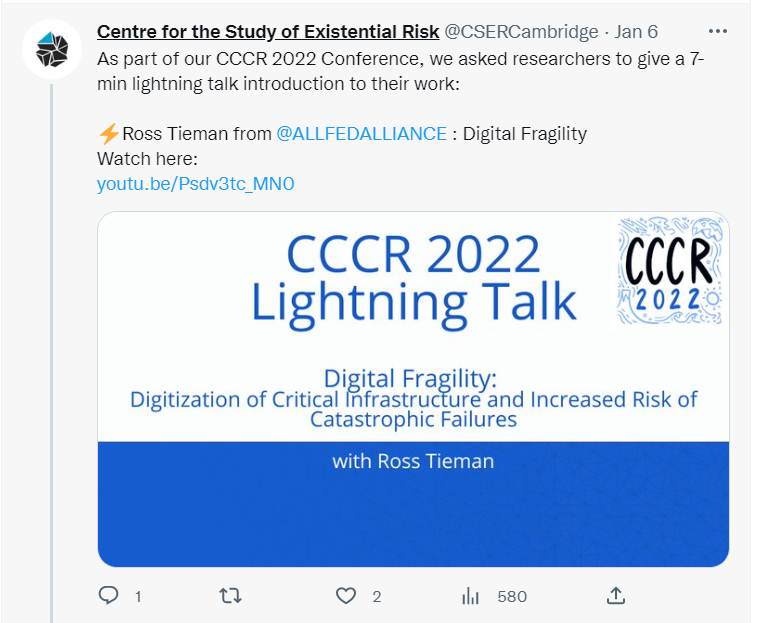
Takeaway
CSER seems too inward-looking for a research group. Original tweets or even quote-tweets about developments in the field would make them seem more worldly.
Future of Life Institute (FLI)
Key Features
- Most-followed account in the sample and the 1st/2nd most-followed EA-aligned organisation of all (depending on whether you include Our World in Data)
- Great balance of in-house and external links. FLI comes across as an org that knows its business and is happy to see others succeed
- Most of the tweets are appeals to click a link, but they vary sufficiently in style to not seem same-y.
- Some tweets are objective-sounding, others emotive, which gives the account an inconsistent voice
Typical Tweet

Takeaway
Balancing in-house content with others’ work gives you credibility. So don’t just tweet when you have something to show off!
Giving What We Can (GWWC)
Key Features
- Constant reminders about the GWWC pledge: testimonials from pledgers, stats on how many have pledged and how much has been raised
- Lots of human faces gives the account a relatable feel
- A surprising lack of references to actual cause areas (other than a few retweets)
- In-house visuals give the account a consistent aesthetic
- Low tweet rate. I have heard from within the org that GWWC would like to increase its output but does not currently have anyone working on social media
Typical Tweet

Takeaway
GWWC’s account helps people imagine themselves as pledgers, but not to imagine the good their donations can do. More quantity and more variety would help.
The Humane League
Key Features
- By far the most emotive account in the sample. A mix of rage and hope. Lots of calls to action (“We’re on a mission to end the abuse of animals raised for food. Are you in?” 13 Jan)
- High volumes of original, in-house content that must be very time-consuming to create. But the result is that every tweet serves as an introduction to the organisation
- Constant emojis and asking for retweets seems a little trashy.
Typical Tweet
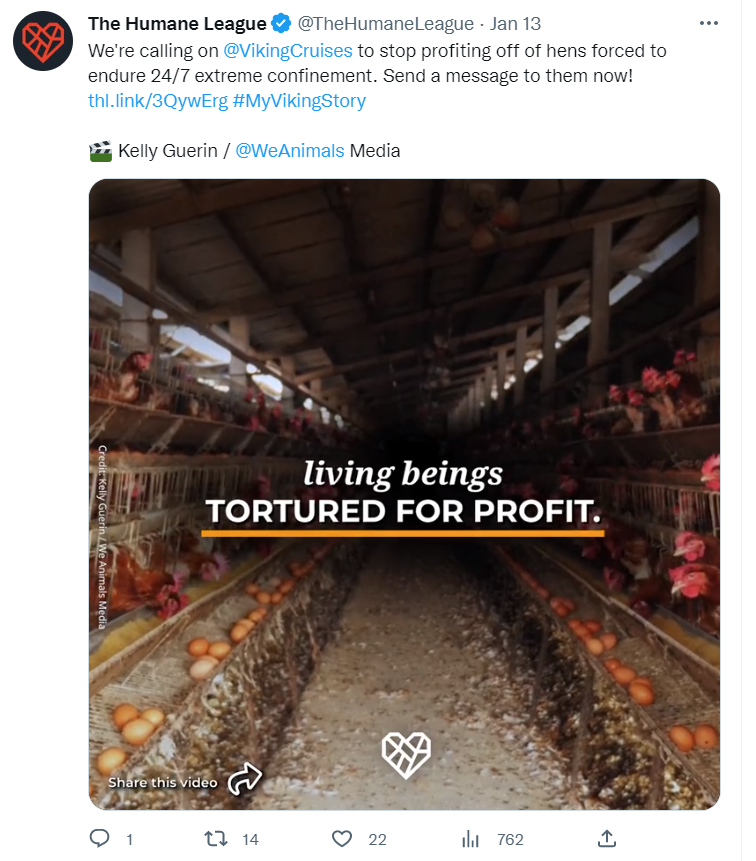
Takeaway
A reminder of how emotive Twitter content can be, and how cerebral most EA-aligned content is in comparison.
Open Philanthropy
Key Features
- Tweets far less than the others in the survey (just once a week!). Have they made a conscious choice to avoid low-fidelity modes of communication? Or does their reliance on billionaire wealth mean that building a following is low-priority?
- Almost every tweet in the sample was for advertising jobs at the organisation. I was surprised to see these dull tweets getting lots of views - probably due to high-profile retweets
- Low rates of engagement with other accounts - no links to external content, and only one other account tagged over a period of 2 months
Typical Tweet
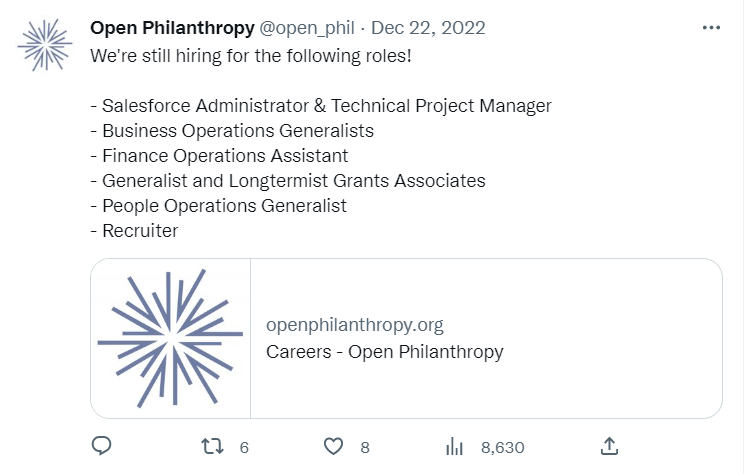
Takeaway
If you’re worried about the effort/dangers of tweeting all the time, just tweet when you need to and let your influential friends spread the word!
Sightsavers
Key Features
- The most active account in the sample
- Regular appeals to justice/inclusivity
- Occasional educational tweets introduce users to cause-relevant things like trachoma, cataracts
- Varied content: a mix of videos & articles featuring both beneficiaries & employees of the charity
- Positive vibes: the emphasis is on sight, not blindness
Typical Tweet
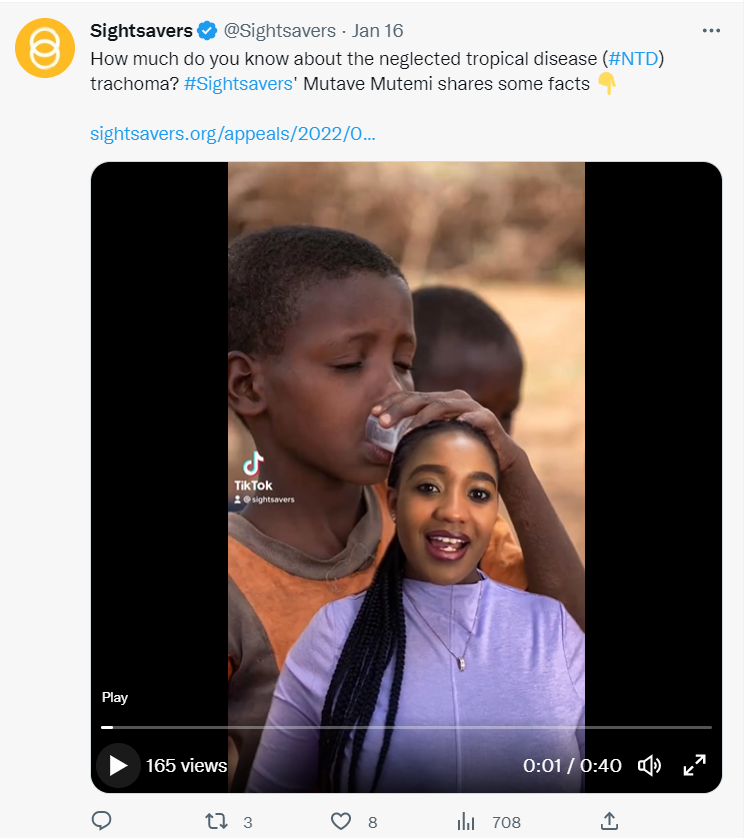
Takeaway
You can be accessible and informative. And if you think you’re the best blindness charity around, don’t give your competitors any publicity(?)
Conclusions
This post gives a snapshot of the different “personalities” of 6 EA-aligned social media accounts, and is intended to build upon my recent quantitative study of EA-related social media. I will suggest two conclusions[3]:
There are some things every organisation should do on Twitter
Every org’s Twitter output should have:
- Varied content (both in writing style & the type of media you link to): this will increase the appeal of your account by “providing something for everyone”.
- Consistent tone: users will start to feel that they know you
- Regular tweets: the only way to compete amid the constant barrage of competing content
This comes with two big caveats: 1) Twitter takes time that may be better spent elsewhere, and 2) being active on Twitter seems to come with a constant low-level threat of finding yourself in a destructive Twitterstorm. If you believe that “the only way to win Twitter is not to take part” you might want to copy Open Philanthropy and rely on high-profile retweets (rather than gradually building a following over time) to get important messages out into the world.
You can design a Twitter personality along key axes
If you are setting a social media policy, it may be helpful for your team to agree where you want your account to sit on these personality axes.
- Objective/Emotive: Do you want to be seen as cool and rational (like CSER), or do you want to rally people to action (like The Human League)?
- Inward/Outward looking: Do you want to keep the limelight to yourself (like Open Philanthropy), or do you want to seem worldly and well-informed (like FLI)?
- Shallow/Deep: Are your tweets designed to be consumed on Twitter (like Sightsavers’ video tweets), or do you want users to click your link for deeper reading elsewhere (like GWWC)?
Want to collaborate?
I would love to do a similar study with a much larger dataset. If you have such a dataset, or have web-scraping or similar skills with which you could assemble one - let's collaborate!
- ^
Methodology
The Sample:
I chose a sample of 6 organisations from among ~20 orgs that:
- Have >8000 followers
- Feature on this 2020 list of EA-related organisations (and therefore also my recent study)
- Have been active on Twitter in recent days
The sample was chosen ad-hoc, making sure to get a representative from each of 4 main EA-related cause areas. I don’t claim or expect that this small sample will be representative of EA organisations in general.
Collecting data:
Looking back from 23:59 on 16 Jan 2023, I collected the 10 most recent original tweets by each organisation.
- If I came across a tweet thread, I only collected the first tweet in the thread.
- Retweets and quote tweets did not count as original tweets, but I tallied these to calculate the “total tweets/week” figure. Tweet threads only counted as 1 tweet for the purposes of this metric
- The line between "In-house" and "external" links is fairly blurred. I did not go to great lengths to determine whether and how each individual was connected to the organisation that mentioned them.
- For the "questions" column I did not count questions that were answered within the tweet.Limitations
- For some organisations the sample stretched over the festive period, when orgs’ Twitter activity was likely to be atypical
- The small sample size meant that a big chunk of the collected Sightsavers tweets were promoting the same thing (a film release), which demonstrates that this sample is a weak proxy for orgs' long-term Twitter activity
- ^
As far as I know. I checked the follower counts of all the orgs on this 2020 list in December 2022, so it's possible I have missed orgs that were missed from the list or that have been recently founded.
- ^
The data doesn’t show a) how intentional these personalities are or b) the effects of these personalities on the perception of and engagement with the actual organisations, so my conclusions do not sit on solid statistical foundations.

Thanks Stan for including GWWC in your analysis!
I definitely think GWWC could be doing a better job on twitter, which you've mentioned above - I'm still considering whether the additional effort is worth it for us at the moment. Regardless I am updating the mix of content to include more about our top-rated charities (this will happen slowly over time).
As an interesting aside - I think people are much less interested in engaging with orgs/brands than they are with individuals. Over the past few months I've experimented with my own twitter account and have found that my personal account with ~1,000 followers gets a lot more engagement on effective giving related content (and even retweets of GWWC content) than our GWWC account with ~12,000 followers.
Another interesting question for you to investigate is whether it's worth it for orgs to ask their staff to be active on social media rather than investing resources in branded accounts.
Thanks for pointing that out. I also get a sense that people are getting more traction than brands in EA twitter. Before my initial social media study I followed very few EA orgs on Twitter and I wasn't getting exposed to new ones, whereas prominent individuals were popping up.
Perhaps orgs should be trying that out. I expect some friction - people who already use social media in a personal capacity may want to keep it separate from their job, while others are consciously off the platforms and actively against spending time on them. Maybe people could just get secondary, job-aligned accounts.
I'm definitely a fan on Twitter of mixing being a prominent org spokesperson with also having a very independent and personal voice. I'm curious how that comes across.
Hi Stan,
This is great! Some questions:
If funded, would you be interested in doing a broader, impartial study of EA and Twitter discourse?
Its embarassing because my methods are so low-tech. I literally went to the Twitter feeds of each org and copied the 10 most recent original tweets into a spreadsheet. Hence the call for someone with data-scraping skills at the end.
My background is: I'm a teacher, run a podcast on Education, looking to transition to a more impactful career, have a degree in Mathematics. Any research skills I have are self-taught.
I don't have a specific vision for a project at the moment but would very much be interested in doing a larger study on EA and Twitter. I'd be interested in projects that i) allow EAs and orgs to better form social media strategies and ii) build my research skills & credibility.
How much would it cost to buy adding an analysis for Rethink Priorities? I think it could be valuable.
I'd love to do that! Just sent you a message.